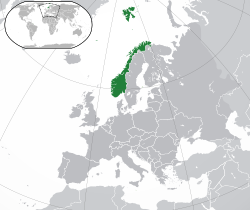
Back Geleitzug PQ 14 German Convoi PQ 14 French PQ–14-es konvoj Hungarian Konwój PQ-14 Polish PQ-14 Russian Конвой PQ 14 Ukrainian
| Convoy PQ 14 | |||||||
|---|---|---|---|---|---|---|---|
| Part of Arctic naval operations of the Second World War | |||||||
 German occupied Norway (in green) along the flank of the sea route to northern Russia | |||||||
| |||||||
| Belligerents | |||||||
| Allies | Germany | ||||||
| Commanders and leaders | |||||||
| Stuart Bonham Carter | Hans-Jürgen Stumpff | ||||||
| Units involved | |||||||
| PQ 14 and escorts | Luftflotte 5 | ||||||
| Strength | |||||||
|
26 merchant ships varying number of escorts | |||||||
| Casualties and losses | |||||||
|
1 ship sunk 16 ships turned back with ice damage | 1 Junkers Ju 88 | ||||||
Convoy PQ 14 was an Arctic convoy sent from Britain by the Western Allies to aid the Soviet Union during the Second World War. Convoys from Britain had been despatched since August 1941 and advantage had been taken of the perpetual darkness of the Arctic winter. German operations against the convoys had been muted due to the need to support Operation Barbarossa, confidence in imminent victory and the small size of the convoys. In late 1941 and early 1942 the Luftwaffe and Kriegsmarine had reinforced Norway with aircraft and ships.
The convoy sailed in April 1942, when the hours of daylight were increasing and the Polar ice had yet to recede. On the night of 10/11 April, thirty hours' sailing in fog and pack ice caused so much damage that 16 vessels had to turn back and return to Iceland. On 16 April, air and U-boat attacks sank one merchant ship and the seven remaining ships in the convoy reached Murmansk. The Allies would have to run larger convoys during the hazardous summer months to catch up with deliveries.
The co-ordination of German aircraft and submarine attacks caused the Navy concern as daylight hours increased towards the perpetual daylight of the midnight sun. Despite the recent reinforcement of convoy escorts, the last four days of the voyage would be under continuous observation and submarine attacks would increase just as the escorts were inhibited by shortage of fuel; the Navy predicted serious losses.